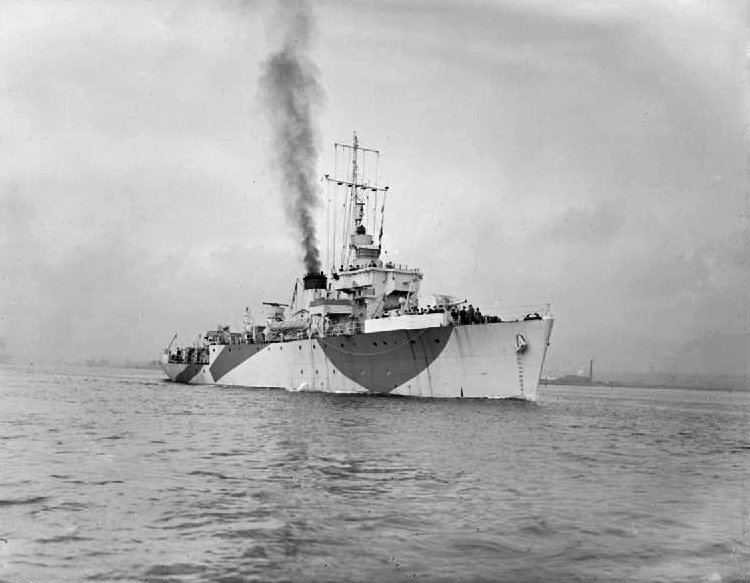The kamikaze attacks launched by the Imperial Japanese military during the tail-end of the fighting in the Pacific during World War II are justly remembered as some of the most desperate, terrifying tactics employed by any of the combatants during that global conflict. While they inflicted a heavy toll on Allied warships and personnel, they claimed the lives of thousands of Japanese pilots in the process and, of course, failed to turn the tide of the war. One photo, in particular, seems to sum up both the ferocity and the futility of this campaign, showing the telltale silhouette of a Japanese raider that slammed, more or less ineffectively, into the side of a British Royal Navy warship on this day, in 1945.
The remarkable image was taken after the County class heavy cruiser HMS Sussex had been struck by a Mitsubishi Ki-51 — a monoplane light bomber that carried the Allied reporting name Sonia — near the Dutch East Indies on July 26, 1945. This was one of two kamikaze raiders that had attempted to target the ship. This particular aircraft impacted the warship just above the waterline, leaving a near-perfect imprint of its shape, but failed entirely to penetrate the cruiser’s hull or cause any significant damage.

According to a Tweet today from the U.S. Naval Institute, HMS Sussex was protected by belt armor that was 4.5 inches thick, although other accounts from naval warfare experts point out that the County class did not carry any additional belt armor, as a result of limits placed on protection by interwar naval treaties, with the kamikaze raider instead ultimately being defeated by an inch of steel.
Some reports suggest that the Ki-51 may have come in so low that it bounced off the top of the waves before impact, with the result that its velocity was significantly reduced. While the aircraft utilized a mainly metal construction, with fabric-covered control surfaces, its overall mass was fairly light, with a maximum takeoff weight of fewer than 6,500 pounds.
Contemporary accounts indicate it wasn’t even initially clear which aircraft type had been responsible, suggesting there was very little left in the way of wreckage. One after-action report describes HMS Sussex being attacked by a Val — the codename for an Aichi D3A dive-bomber. The aircraft “was sighted approaching from the starboard beam, flying straight and at about deck level, heading for the after superstructure. He was engaged by the close-range armament and was shot down in flames, the pilot being seen to throw up his hands before the aircraft finally crashed, hitting the ship’s side abreast the mainmast.”
This same account goes on to detail the damage to the warship — an eight-foot split in the side plating located around 8 feet above the waterline, and some minor distortion to panels on the hull.
Being shot down by the warship’s anti-aircraft defenses was by no means an unusual fate for the suicide raiders.

Of course, the Sonia would have been armed with explosives as well — this adapted light bomber could carry up to around 550 pounds of bombs for kamikaze operations. But these clearly didn’t detonate, and they may well have been torn off the aircraft once it first impacted the water.

The War Zone spoke to Mike Yeo, author of Desperate Sunset: Japan’s kamikazes against Allied ships, 1944–45, who has identified the particular unit from which the Ki-51 was drawn. This was an Imperial Japanese Army Air Force training establishment based in northern Malaya, where it was preparing to try and repulse an expected Allied invasion of Malaya and Singapore, and it was involved in several waves of attacks against Allied warships on the 26th.
In Yeo’s account, it was the first Ki-51 that was successfully shot down by the anti-aircraft guns on Sussex, while the second managed to press home its attack, striking the vessel and leaving its imprint on its hull. His findings include reports of “dents, scrapes, and scorch marks on the side of its hull,” together with the possibility, at least, that the aircraft’s fixed undercarriage impacted the water prior to impact.
A colorized image of the kamikaze impact on HMS Sussex:
That there is still some confusion surrounding the exact sequence of events of the attack on HMS Sussex is hardly surprising, given the chaos of a kamikaze raid.
While this particular suicide raider was unsuccessful, it’s worth noting, too, that another Sonia pressed home its attack on the Royal Navy minesweeper HMS Vestal on the same day, causing critical damage and killing 20 of the ship’s crew. This would be the last British naval vessel to be lost to enemy action during World War II.

In another strange twist to the HMS Sussex’s campaign, one sailor, George Coyne, later recalled that a Japanese ship was sunk, too, leaving around 20 survivors in the water. “One of our ships, at great risk to themselves, stopped to rescue them,” Coyne said, “Without exception, they refused help and so drowned.”
Less than a month after the attack, Japan had surrendered, the commander of the Japanese garrison in Singapore, General Seishirō Itagaki, signing the surrender documents on behalf of the army aboard the Sussex on September 5, 1945.

“Thank God for the bomb,” Coyne wrote in his diary at the time. “We should now get home safely.”
As it is, this haunting image from the attack on HMS Sussex stands testimony to the brutality of the Pacific campaign and the fine line between those ships that survived to fight another day, and those that would not.
With thanks to Mike Yeo, who you can follow on Twitter here.
Contact the author: thomas@thedrive.com
